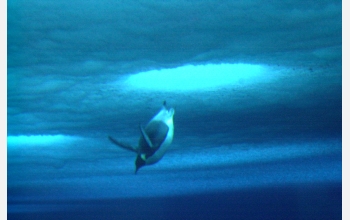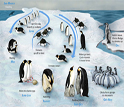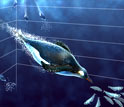Media Advisory 06-033
Video Explains What Science Learns From Avian Stars of "Happy Feet" and "March of the Penguins"
Understanding Emperor penguin physiology may one day aid doctors

An Emperor penguin dives through a hole into the water below the McMurdo Sound sea ice.
November 15, 2006
For b-roll on Betacam SP format or in a high-definition format of Emperor penguins in Antarctica and Q's and A's with Emperor researcher Paul Ponganis, of the Scripps Institution of Oceanography, and Roberta L. Marinelli, NSF's biology and medicine program director, contact Dena Headlee, (703)292-7739, dheadlee@nsf.gov
To preview and request this video you may also log on to www.thenewsmarket.com/nsf. It is possible to both receive broadcast-standard video digitally or by tape from this site. Registration and video are free to the media.
This material is available primarily for archival purposes. Telephone numbers or other contact information may be out of date; please see current contact information at media contacts.
Long before they lit up movie screens in animated feature films or enthralled documentary film audiences worldwide with the story of their endless struggle to survive and reproduce, Emperor penguins intrigued early Antarctic explorers.
As movie makers prepare this weekend to release "Happy Feet," about an animated Emperor who loves to dance, and the Hallmark Channel readies the cable-television premier of the documentary "March of the Penguins" on Sat., Nov. 25, 2006, the National Science Foundation (NSF) is making available B-roll of the penguins in Antarctica. The agency is also offering journalists the opportunity to ask Antarctic researchers questions about why the birds still challenge the scientific mind.
On the eve of International Polar Year (IPY), Emperor penguins, which can dive unharmed to depths that no human could survive unaided, still fascinate researchers.
By studying the animals' physiology and the way their bodies respond to the crushing pressure of deep dives, these NSF-funded scientists, who also are medical doctors, may one day provide clues to help improve surgical procedures and anesthesia. The study of Emperors also is very much in the spirit of NSF's IPY theme of attempting to understand what makes the processes of life in the cold and dark unique.
The video describes a fascination with Emperors that dates to the early 20th century. In the mistaken belief that Emperor penguin embryos might shed light on evolutionary links between reptiles and birds, three British explorers set out in 1911, pulling sleds through the unending blackness and almost unbearable cold of an Antarctic winter, to reach the penguins' nesting grounds at Cape Crozier to collect their eggs. An account of the expedition, "The Worst Journey in the World," became an undisputed classic of polar literature. "Antarctic exploration is seldom as bad as you imagine," wrote its author Apsley Cherry-Garrard. "But this journey has beggared our language: no words could express its horror."
Two eggs broke during the return journey. Three were preserved. But by the time the studies of the eggs were published in the 1930s, the hypothetical link between penguins and reptiles had been discounted. The eggs and embryos remain today at the Natural History Museum in London.
International Polar Year begins in March 2007, and will be devoted to advanced scientific exploration at the Earth's poles.
-NSF-
-
Depicted here is a summary of an Emperor Penguin's yearly lifecycle.
Credit and Larger Version -
Scientists study penguin's physiology to learn how they can dive so deep.
Credit and Larger Version -
Unlabeled version. Scientists study penguin's physiology to learn how they can dive so deep.
Credit and Larger Version
Media Contacts
Peter West, NSF, (703) 292-7761, email: pwest@nsf.gov
Mario Aguilera, assistant director of communications, Scripps Institution of Oceanography, (858) 534-3626, email: maguilera@ucsd.edu
Pam Slay, vice president, network program publicity, The Hallmark Channel, (818) 755-2480, email: PamSlay@hallmarkchannel.com
Related Websites
U.S. interagency International Polar Year (IPY) Web site: http://www.us-ipy.gov
U.S. Antarctic Program: http://www.nsf.gov/news/news_summ.jsp?cntn_id=102869
Significant U.S. Science Discoveries from Antarctica: http://www.nsf.gov/news/news_summ.jsp?cntn_id=100855
The U.S. Antarctic Program's photo library: http://photolibrary.usap.gov/index2.htm
Scripps Institution of Oceanography's Explorations Web site on NSF-Funded Emperor researcher Gerald Kooyman: http://explorations.ucsd.edu/penguins/
The U.S. National Science Foundation propels the nation forward by advancing fundamental research in all fields of science and engineering. NSF supports research and people by providing facilities, instruments and funding to support their ingenuity and sustain the U.S. as a global leader in research and innovation. With a fiscal year 2023 budget of $9.5 billion, NSF funds reach all 50 states through grants to nearly 2,000 colleges, universities and institutions. Each year, NSF receives more than 40,000 competitive proposals and makes about 11,000 new awards. Those awards include support for cooperative research with industry, Arctic and Antarctic research and operations, and U.S. participation in international scientific efforts.
Connect with us online
NSF website: nsf.gov
NSF News: nsf.gov/news
For News Media: nsf.gov/news/newsroom
Statistics: nsf.gov/statistics/
Awards database: nsf.gov/awardsearch/
Follow us on social
Twitter: twitter.com/NSF
Facebook: facebook.com/US.NSF
Instagram: instagram.com/nsfgov



